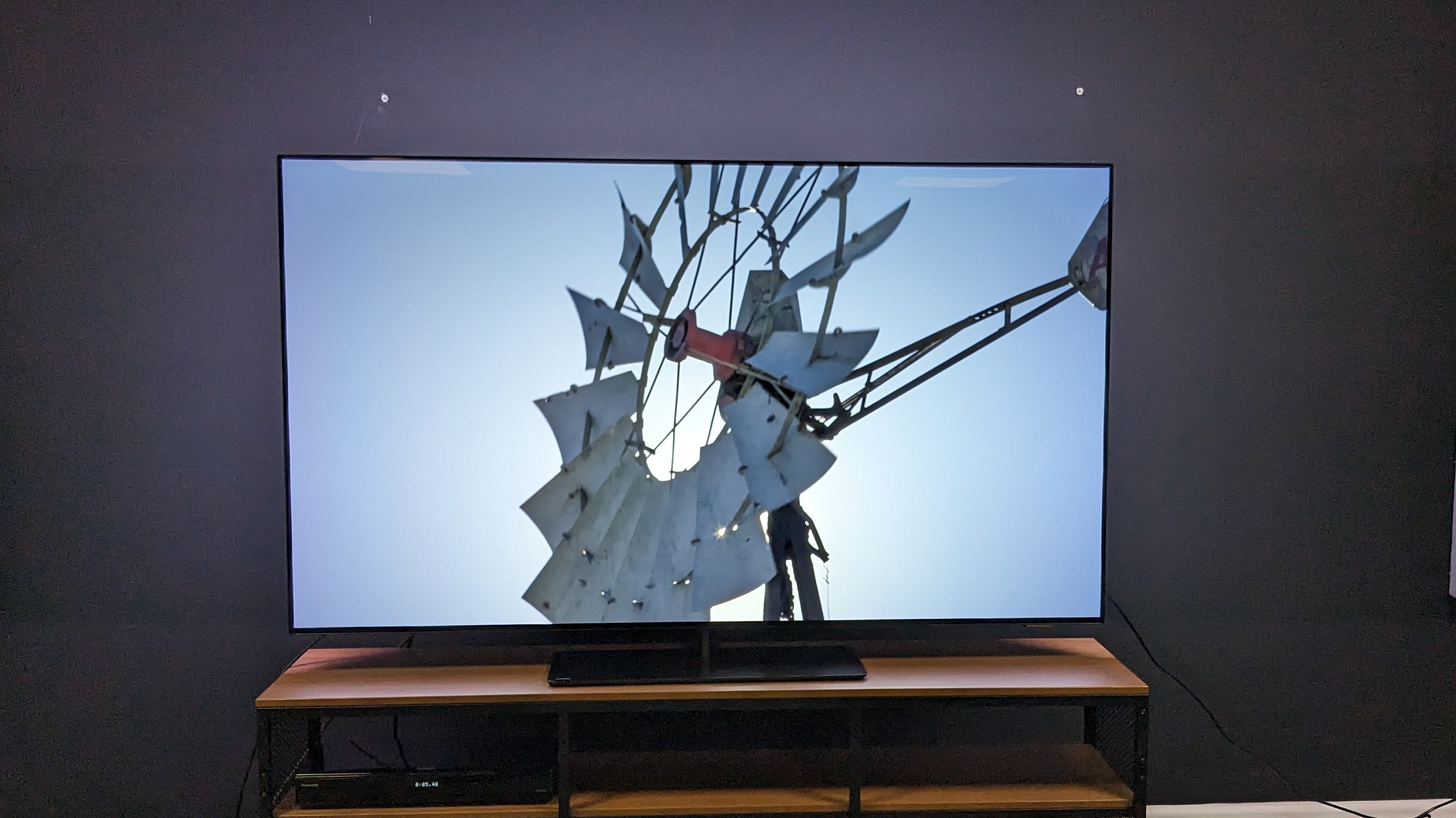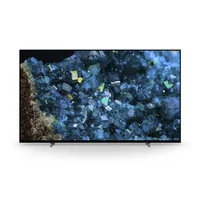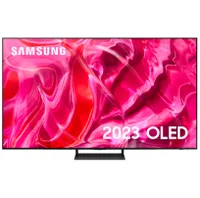TechRadar Verdict
The Philips OLED808 has a unique feature with Ambilight that adds an extra layer to a viewing experience. Combine this with stunning picture quality, great gaming performance and a beautiful design and you have one excellent TV. It may not be the best performer in every area, but it still justifies itself as a top OLED contender.
Pros
- +
Vibrant, colourful picture
- +
Unique Ambilight gives wow factor
- +
Great gaming performance
Cons
- -
Only two HDMI 2.1 ports
- -
Game mode bare compared to other OLEDs
- -
Not the neatest smart TV platform
Why you can trust TechRadar
Philips OLED808 review: Two minute review
The Philips OLED808 is the mid-range OLED TV in Philips’ 2023 lineup. Featuring an OLED EX panel to improve brightness levels over standard WOLED panels, the OLED808 also comes with Philips’ unique Ambilight feature built-in for added immersion, colour and to reduce eye strain in darkened viewing conditions. It’s worth noting that the 42 and 48-inch models of the OLED808 do only come with a standard W-OLED panel and not the brighter OLED EX panel.
In terms of price, the Philips OLED808 is a very competitively priced OLED. The 65-inch, which we used in our test, is priced at £1,799 at the time of writing, meaning it sits only £100 higher than other comparable OLEDs such as the Samsung S90C and the LG C3. In all of its sizes, the Philips OLED808 is almost like-for-like with the LG C3, although it does sit a little higher priced at the time of writing.
The OLED808’s picture quality is superb. Colours are the real highlight of the OLED808’s picture, with a vibrancy and dynamic punch that makes them pop out of the screen. Thankfully, the colours still are natural and avoid looking overblown or garish. Black levels are deep and shadow detail is excellent and a rich, detailed contrast brings the picture together. There’s also a defined sharpness to the image that means textures are true-to-life and skin tones are accurate, giving it a picture quality that sits amongst the best TVs.
Sound quality on the OLED808 is good, with a nice balance in the mix and a particular highlight being its powerful bass. The sound also does a fantastic job of following the action on screen, keeping you immersed in the action. Although the OLED808 supports Dolby Atmos, these effects are a little lost in the audio and can be tricky to pick out. There are times when the OLED808 does distort a little as well when pushed. Overall though, the built-in sound of the OLED808 is good enough that it’ll suit a lot of viewers.
The OLED808 comes with plenty of gaming features including 4K, 120Hz (of which there are two types in the OLED808) VRR, ALLM and all the other features a gamer could need. In terms of performance, the OLED808 handles fast paced, challenging moments well and has the picture to go along with it. A more fleshed out Game mode would have been nice, but nevertheless, the OLED808 is a great gaming TV.
Design is the OLED808’s strongest highlight, mainly thanks to its Ambilight feature. A unique feature that adds that little extra, Ambilight takes movie viewing to another level with stunning, colourful lights that can dazzle when viewed with the right movies and TV shows. The supplied stand also has a reassuringly expensive feel to it and the TV itself, although not as slim as other TVs, is still sleek and attractive.
Using Google TV as its smart TV platform, the home page can get a little overwhelming with recommendations and ads, but is still intuitive enough. Also, a quick menu while watching TV shows and movies to make quick adjustments would have been nice. There are however plenty of settings to tweak to tailor the picture and sound to suit anyone.
Sign up for breaking news, reviews, opinion, top tech deals, and more.
When Philips first announced pricing for the OLED808 in September, it seemed overly expensive for what specs it had, which are close to the LG C3. Thankfully, only a matter of weeks after its release in October, prices have dropped to near enough the same level as other rival OLEDs and with the added inclusion of Ambilight, the OLED808 gives you a lot of bang for your buck.
Overall, the Philips OLED808 is a fantastic TV. It may not be the top performer in every area, but what you do get in this one package makes for an excellent TV that’s almost sure to feature as one of the best OLED TVs. And let’s not forget that its Ambilight feature does give it an added extra flavour that makes it a stand-out in the TV market.
For this review, I tested the 65-inch version of the Philips OLED808.
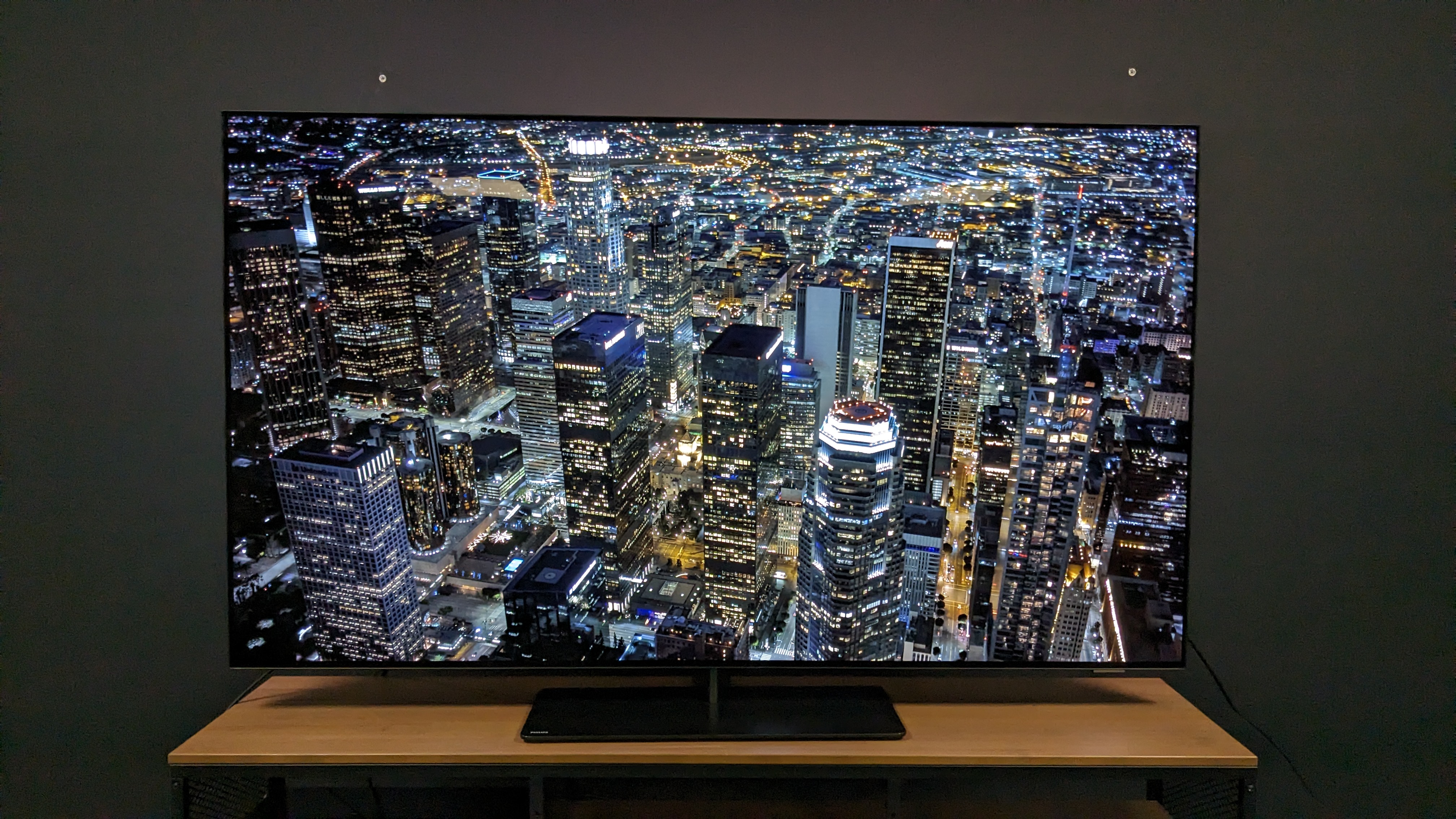
Philips OLED808 review: Prices and release date
- Released October 2023
- Prices range from £1,099 for the 42-inch
- To £3,199 for the 77-inch
The Philips OLED808 is the mid-range OLED TV in Philips’ 2023 lineup, preceded by the OLED708 and sitting below the flagship OLED908. At the time of its release in October 2023, the Philips OLED808 was priced as follows:
- 42-inch: £1,399
- 48-inch: £1,499
- 55-inch: £1,799
- 65-inch: £2,199
- 77-inch: £3,799
At the time of writing only a couple of weeks after release, we have seen prices drop, with the 65-inch version that we tested at £1,799 and the 55-inch version at £1,399. In comparison to rival OLEDs such as the LG C3, Samsung S90C and Sony A80L, this is almost identical pricing, if not cheaper.
Philips OLED808 review: Specs
| Screen type | OLED EX |
| Refresh rate | 120Hz |
| HDR support | Dolby Vision, HDR10+, HDR10, HLG |
| Audio | Dolby Atmos, DTS:X |
| HDMI ports | 4 (2x HDMI 2.1) |
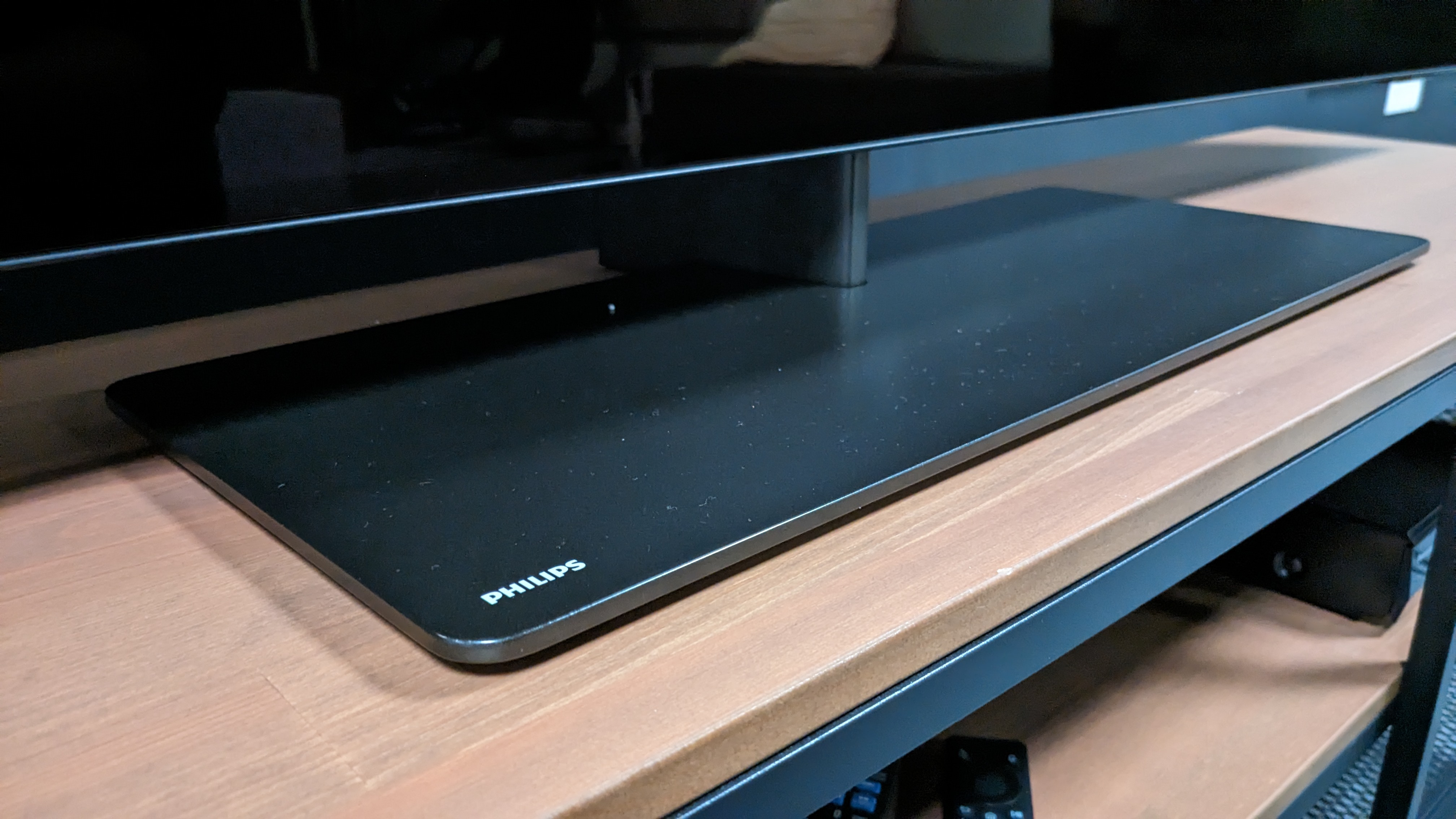
Philips OLED808 review: Features
- Ambilight technology
- Dolby Vision and HDR10+ support
- No Freeview Play apps
The Philips OLED808 features an OLED EX panel, the same one found in other OLEDs such as the LG C3. This aims to increase the overall brightness in comparison to a standard W-OLED panel. It is worth noting again that the OLED EX panel is only available on 55-inch-plus sizes of the OLED808, however, and that the 42-inch and 48-inch versions use a standard W-OLED panel.
The most unique feature on the OLED808, and on most of Philips’ TVs, is Ambilight. Three sides of the panel’s rear have lights that can be changed to a variety of colours and moods to suit any viewing environment. You can set the Ambilight to a solid colour to match the wall or to follow the colours of the movie or TV show you’re watching. You can even set it to follow audio if you’re listening to music. Alternatively, if it’s not your thing you can always turn it off.
In terms of gaming features, the Philips OLED808 has only two HDMI 2.1 ports but is otherwise well-stocked, with 4K 120Hz, VRR, ALLM, AMD Freesync Premium Pro, Nvidia Gsync and HGiG compatibility. It also supports Dolby Vision gaming, even at 4K 120Hz. There’s also a Game mode included that maximises gaming performance by turning off any unnecessary settings in the TV such as motion smoothing. Its Game mode feels a little more bare compared to those found on other TVs from LG, Samsung, Sony and Panasonic, but is nonetheless effective.
Equipped with a 2.1-channel audio system, the OLED808 supports Dolby Atmos and DTS:X audio formats. With four mid-high placed speakers and a built-in subwoofer, the OLED808 aims to use its configuration to spread the sound as much as possible with 70W of power.
Using Google TV as its smart TV platform, the Philips OLED808 offers a lot of customization options and recommendations for TV shows and movies the platform thinks you will enjoy. There are plenty of settings to adjust for picture and sound. In terms of apps, the OLED808 has access to Netflix, Disney Plus, Prime Video and more. However, it is important to note that, at the time of writing, the Philips OLED808 does not come with Freeview Play or any of the UK Freeview Play apps such as BBC iPlayer, ITVX or Channel 4.
- Features score: 4.5/5

Philips OLED808 review: Picture quality
- Vivid and dynamic colours
- Rich, deep contrast
- Superb detail
The Philips OLED808 has an OLED EX panel, the same found in the LG C3, which improves brightness levels over conventional OLED (W-OLED) panels. Philips’ aim is clearly to prioritise colour over anything else, boasting a 99% DCI-P3 Colour Gamut in order to maximise the potential of the Ambilight TV. In terms of picture quality, the OLED808 is a winner in a lot of areas.
For this review, I used the 65-inch version of the Philips OLED808 and it’s worth noting again that the OLED EX panel is only featured in the 55, 65 and 75-inch versions. The 42- and 48-inch both feature standard W-OLED panels, meaning their brightness levels will be lower than the larger models.
I first cycled through the various picture preset modes to establish which was the most accurate and landed on Filmmaker Mode. Standard was another strong choice, particularly for SDR content as it gave a little extra colour, but for HDR sources Filmmaker mode was the best.
Starting out watching SDR sources, both low-resolution and HD, the OLED808 did a great job of upscaling. I watched numerous live TV shows through the antenna and was impressed by the OLED808’s upscaling, which added extra detail and sharpness to the image, particularly on HD TV shows. Textures were a little fuzzy on the low-resolution content, but this was to be expected to an extent given the large 65-inch screen size. But even so, the picture was clear.
I next moved on to 4K HDR sources and the OLED808 had a superb, crisp and punchy picture overall. In the specs, Philips claims 99% DCI-P3 colour gamut (the colour space used to master 4K Blu-ray and digital cinema releases) coverage. When I measured the OLED808’s DCI-P3 and BT.2020 coverage using Portrait Displays’ Calman calibration software, it yielded results of 99.2% and 74% respectively, which are outstanding results that beat TVs such as the LG C3 and even the more premium LG G3.
Using the Spears & Munsil UHD HDR Benchmark 4K Blu-ray first to test the OLED808’s colour, contrast, sharpness, black level and more, the OLED808 handled all of the demo footage effortlessly. Nature scenes looked crisp, with colours popping from the screen. Contrast was excellent, with blacks of the night sky and the bright lights of a city balancing perfectly to showcase the OLED808’s detail. Daytime landscape shots looked beautiful, with lifelike textures and lush colours.
To test shadow detail and black levels, I next watched The Batman. Viewing several scenes, the OLED808 perfectly captured the dark and gritty tone of the movie. Black levels were as deep as I’d hoped and shadow detail was superb. In the opening subway fight scene, there was a perfect contrast between the gloomy platform and lights of the surrounding city, meaning no details went missing. When I measured the grayscale of the OLED808, recording its Delta-E values (the margin of error between a test pattern and what’s shown on screen), I was surprised to find it scored a 4.1 (we typically look for a result of below 3). Despite this average score, blacks and colors still looked fantastic on the OLED808.
For Dolby Vision testing, I used scenes from both Star Wars: The Last Jedi and Godzilla vs Kong. During the throne room lightsaber scene in Star Wars: The Last Jedi, the lightsabers were punchy and dynamic as they flashed around the screen. Red is a prominent colour in the scene and it looked eye-catching without being too overblown. In one of the climactic scenes of Godzilla vs Kong where Godzilla stomps around the streets of Tokyo, the neon signs pulsed and dazzled with rich detail and a stunning vibrancy that jumped from the screen. In both scenes, skin tones and textures were incredibly accurate and looked as true-to-life as you could hope.
When measuring the OLED808’s peak brightness levels using Calman, it yielded a result of 789 nits on a 10% HDR window in standard mode and 808 nits in Filmmaker mode. This is not surprising as the OLED808 uses the same panel as the LG C3, which gave a similar score of 830 nits in its Filmmaker mode. Despite not reaching the peak brightness levels of other OLEDs such as the Samsung S90C, the Philips OLED808 was still bright enough during my evaluation.
For motion testing, I used Top Gun: Maverick, focusing particularly on the training exercise and the final mission. In both scenes, which feature intense aerial combat and movements such as barrel rolls and fast dives, the OLED808 did a superb job of processing these incredibly fast scenes, even in Filmmaker mode with all motion processing turned off. Every time a jet roared across screen, the panning motion was slick and seamless, and it immersed me in the action.
- Picture quality score: 4.5/5

Philips OLED808 review: Sound quality
- Wide soundstage
- Great balance of sound
- Can distort at higher volumes
The Philips OLED808 has 2.1 channels of audio across four high to mid-placed speakers and a single subwoofer, totalling 70W of power. Although it doesn’t have the most powerful sound on the market, compared to TVs like the Sony A80L and the Panasonic MZ2000, the sound quality is good enough that it should suit a lot of listeners.
When first choosing a sound mode using one of the OLED808’s built-in presets, it became clear that the best was one called Entertainment (which seemed to mirror Cinema/Movie on other TVs). First using the Batmobile chase scene from The Batman, the sound of the rumbling engines was powerful, giving the satisfying shake you expect from a movie with strong bass. The wide soundstage made the scene feel even more dynamic, as the sound perfectly mirrored what was on screen as tyres screeched and cars crashed all around.
Next I used scenes from Top Gun:Maverick and was again pleased to find that the sound followed the action on screen, as the engines of the jets sounded suitably weighty and the virtual surround sound did a good job of enveloping me as I watched. One thing to note is that although the OLED808 does support Dolby Atmos, in both movies the Atmos effects were present but seemed to get lost a bit in the mix. Also, during Top Gun: Maverick, the speakers did start to distort a little when pushed to higher volumes, though this wasn’t an issue in The Batman. Overall, the built-in sound of the Philips is suitably balanced and powerful, with a good even mix across trebles, mids, bass and speech.
- Sound quality score: 4.5/5

Philips OLED808 review: Design
- Ambilight technology
- Solid metal stand with rotation
- Screen trim not quite as slim as other OLEDs
When talking about the design of the OLED808, it’s impossible not to talk about the fantastic Ambilight feature. With the ability to project light out the back of the TV in an array of colours, the OLED808 adds an experience to movies and gaming that no other TV can. You can have Ambilight follow the video on screen, project static colours such as blue, red or green to create a mood or you can have it follow audio if you choose to stream music from the set itself. It’s a truly unique feature that sets Philips apart from the rest of the TV market.
The supplied stand for the OLED808 is a sleek, black metal base that feels suitably weighty and expensive (even compared to other OLEDs such as the LG C3 and Sony A80L) and fits nicely with the design of the TV itself. The stand also has the ability to pivot, which is a very welcome extra feature. The TV itself is slim and attractive, although the screen’s surrounding bezel is a little thicker than on other OLEDs.
The OLED808’s supplied remote is one of the more refined-looking ones I’ve seen this year, with Philips opting for a slimmer, toned-down design in comparison to remotes from brands like LG and Panasonic. It also has an attractive, black sheen finish that matches the expensive feeling quality of the TV and its stand.
- Design score: 5/5
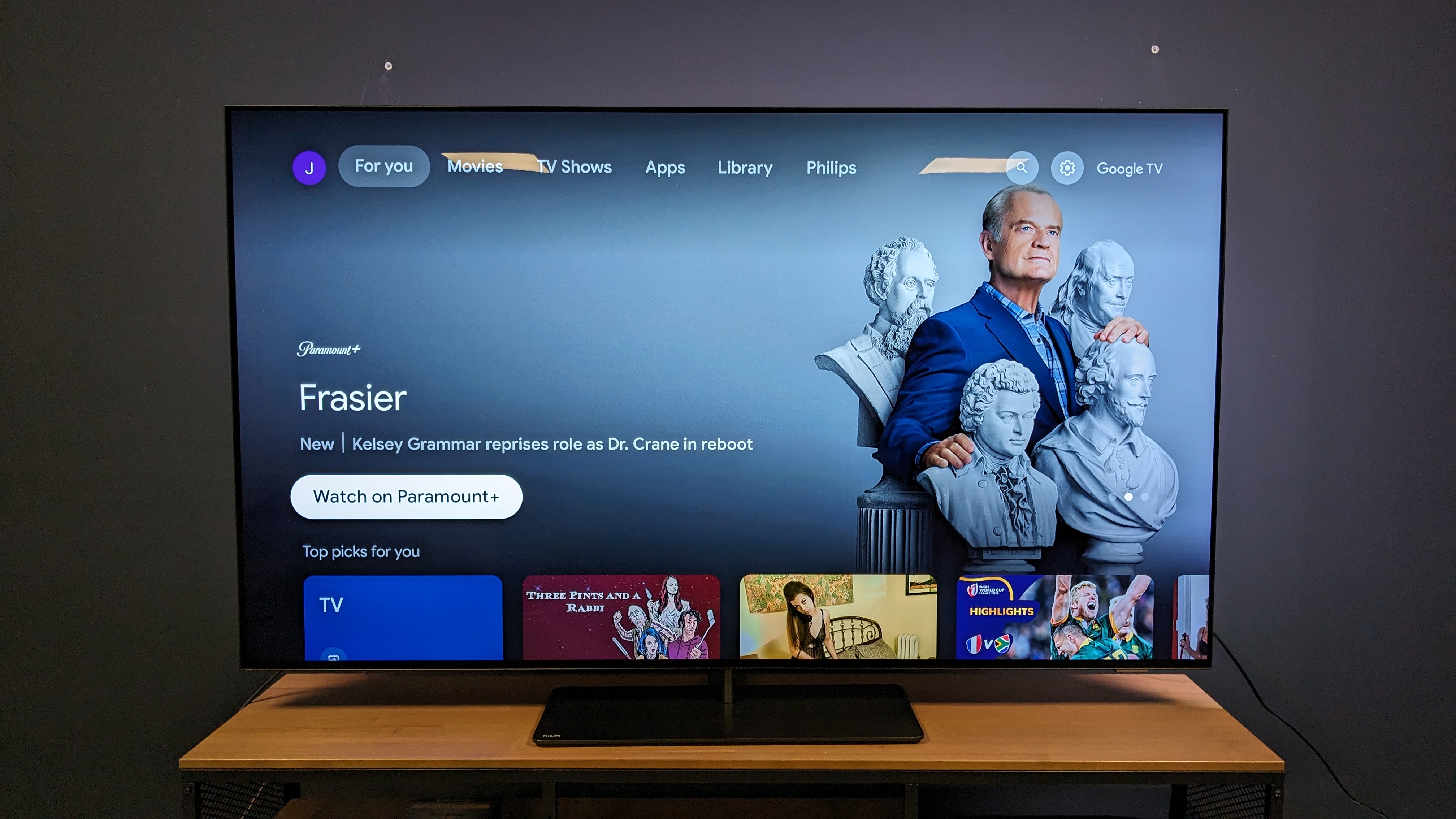
Philips OLED808 review: Smart TV and menus
- Google TV smart TV platform
- Plenty of settings to adjust
- A quick settings menu would be nice
The Philips OLED808 comes loaded with Google TV as its smart TV platform. Google TV offers plenty of recommendations based on your viewing from across various apps. There are arguably too many recommendations at times, which front-loads the screen with ads. There is however a more grid-like ‘Apps’ page that is more toned down for those who want a simpler menu.
In terms of settings and menus, there are plenty of options to adjust to suit the picture to your needs, with many picture preset modes that can be tweaked. There are options to tailor the sound to your environment as well. It may not have the same level of customization as the Panasonic MZ2000, but it has plenty to offer overall.
One feature that was missing that would have been a welcome addition is a quick menu as found in webOS 23 on LG’s TVs. With that, you simply press the settings button on the remote and a menu in the top corner to adjust picture mode, sound output and more. With Google TV, however, you hold down the Home button, scroll over to picture settings and the image itself disappears until you change a setting. It may seem small, but this would have been a useful feature to include.
- Smart TV and menus score: 3.5/5
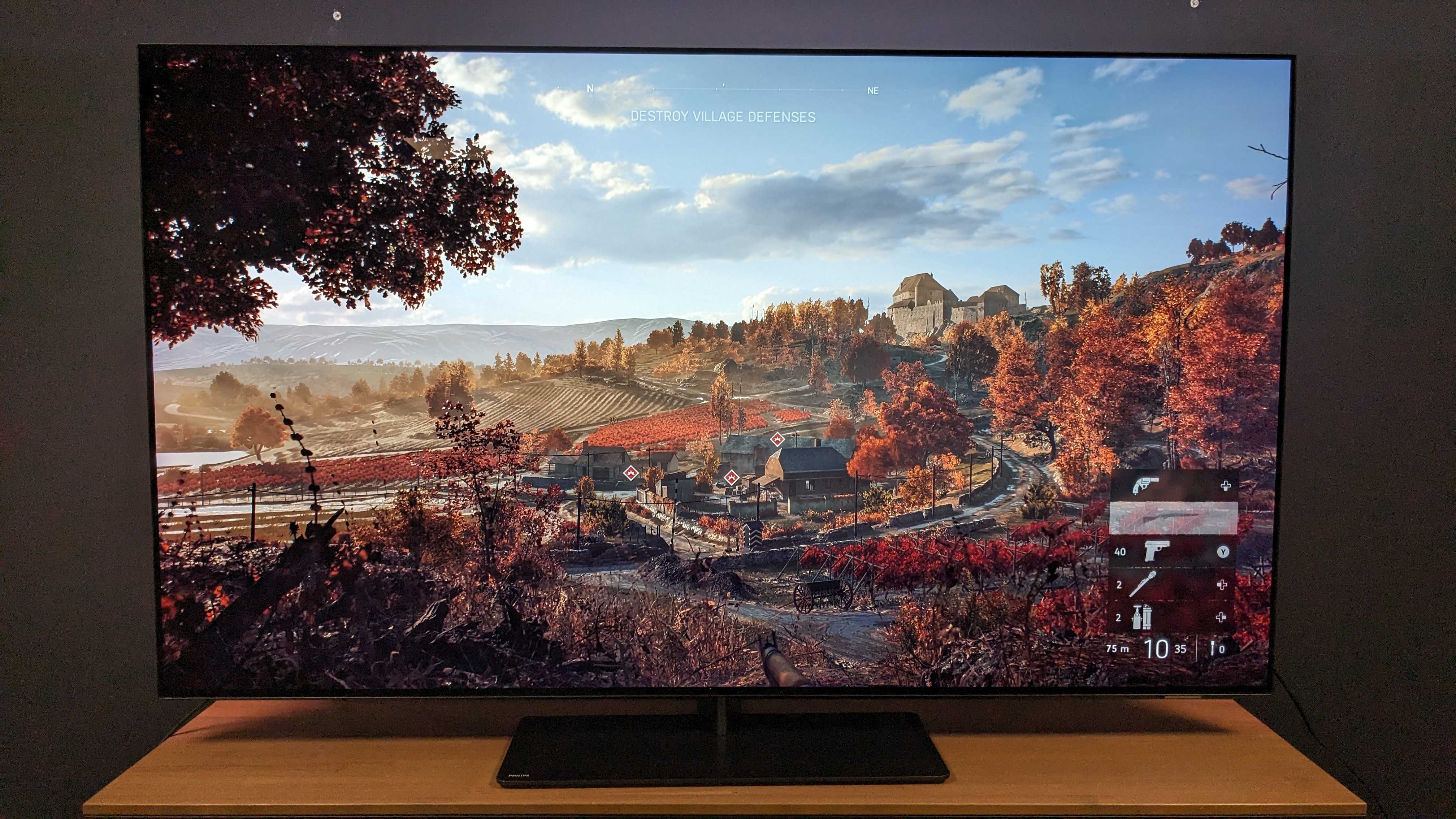
Philips OLED808 review: Gaming
- 4K 120Hz and Dolby Vision gaming support
- Game mode
- Only two HDMI 2.1 ports
The OLED808 is a well stocked gaming TV with extensive gaming features including 4K 120Hz, Dolby Vision gaming, VRR, ALLM, AMD Freesync Premium and Nvidia G-Sync. Performance-wise, it also more than handles graphically intense moments and the picture quality of video games is sharp, crisp and detailed.
Playing Battlefield V on the Xbox Series X, during an autumnal mission focused in the woods, the reds and browns were luscious, vibrant and clean. There was a defined sharpness to the textures of the landscape and intricate details on characters' facial features and even the weapons (which take up a good portion of the screen).
In terms of performance, 120Hz gaming felt suitably fast-paced and fluid, capturing the adrenaline-fuelled intensity of the mission. Quick switching between targets was effortless and scanning the environment was incredibly smooth. One interesting feature I found was that in the HDMI settings (to enable 120Hz), there were actually two 120Hz settings: Game mode VRR and Game mode 120Hz Pro. 120Hz Pro was labelled as for ‘professional gaming’. Switching between the two modes, 120Hz Pro did actually feel faster when moving in different directions, but the VRR Game mode also felt incredibly intuitive.
Using the Leo Bodnar 4K HDMI input lag tester, input lag on the OLED808 measured at 12.8ms at 4K/60Hz. That's a great result, though one that doesn’t quite match the sub-10ms times of LG OLEDs, but it didn’t seem to affect the OLED 808’s gaming performance at any point.
The OLED808 also comes with a dedicated Game mode, which turns off any picture enhancements and activates the best settings for gaming. There were some settings to experiment with, but the Game mode felt a little empty compared to the Game modes found on TVs from LG, Samsung, Sony and Panasonic. There’s also no game bar for editing settings on-the-fly which would have been a bonus feature as well. But performance-wise the OLED808 certainly holds its own against more premium OLEDs such as the LG G3.
- Gaming score: 4.5/5
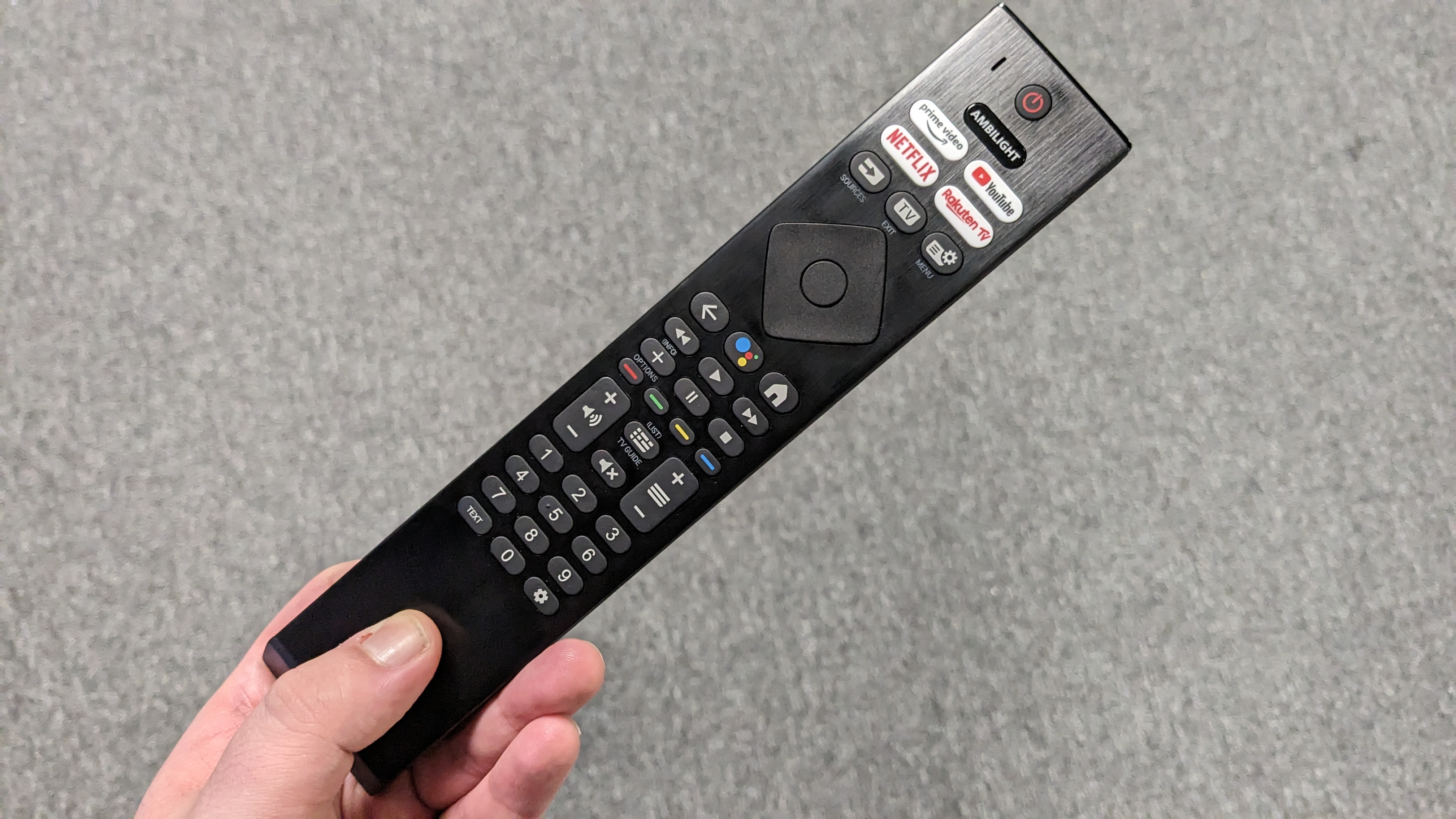
Philips OLED808 review: Value
- Competitively priced with other OLEDs
- Ambilight technology is a unique feature
- Excellent picture and performance for the money
Compared to rival OLED TVs such as the Samsung S90C and LG C3, the Philips OLED808 is almost identical in pricing. For this, you are getting the excellent and unique Ambilight feature that sets the OLED808 apart from the crowd. Not only that, but you are getting similar if not better levels of picture quality and performance to a lot of those rival OLEDs as well.
For the 65-inch version of the OLED808, the same we used in our test, you are looking at £1,799 at the time of writing. The Samsung S90C, the OLED808’s main competition, and the closest equivalent LG set, the LG C3, are both priced at £1,699 for their 65-inch versions. Bearing in mind the Philips OLED808 has only just been released, albeit at a lower than expected prices, we could still see prices fall, which would make the Philips OLED808 a real contender for best value OLED TV.
Admittedly, the OLED808 doesn’t quite have the full package of some of the other TVs. There are only two HDMI 2.1 ports and its sound system is not as refined as the Samsung S90C’s, but it does still have plenty to offer in terms of picture and performance, and there's the delightful Ambilight feature as well.
- Value score: 4.5/5

Should I buy the Philips OLED808?
| Features | Great mix of features for movies and gaming | 4.5/5 |
| Picture quality | Punchy colours, deep black levels and natural textures | 4.5/5 |
| Sound quality | Powerful, accurate but not quite as punchy as some other OLEDs | 4/5 |
| Design | Ambilight is a stunning and unique feature that gives the OLED808 a design edge | 5/5 |
| Smart TVs and menus | Google TV has a few too many recommendations, but plenty of settings to tweak | 3.5/5 |
| Gaming | Great gaming performance and a mix of features, but only two HDMI 2.1 ports | 4.5/5 |
| Value | Competitively priced with the extra flavour of Ambilight to sweeten the deal | 4.5/5 |
Buy it if...
You want dynamic and vivid colours
The OLED808's colours are luscious and vibrant, jumping out of the screen on whatever source is thrown its way, with HDR being a real highlight.
You want something unique
Philips' Ambilight technology won't be to everyone's taste, but it adds an extra layer of immersion and even fun to a viewing experience.
You want a great TV for gaming
With plenty of gaming features including 4K, 120Hz, VRR and Dolby Vision gaming, the Philips OLED808 is a well-stocked gaming TV.
Don't buy it if...
You want the best smart TV platform
Google TV offers plenty of settings to tweak, but its home menu is a bit cluttered and it's not the smoothest to navigate.
You need multiple HDMI 2.1 ports for gaming
The OLED808 only has two HDMI 2.1 ports, whereas rival OLEDs such as the LG C3 and Samsung S90C have the full four available.
Game mode is a little bare
While the OLED808's Game mode does the job, there's no game bar and there are less options to adjust than you'd find on LG, Samsung and Panasonic TVs.
Also consider...
| Row 0 - Cell 0 | LG C3 | Sony A80L | Samsung S90C |
| Price (65-inch) | £1,699 | £1,899 | £1,699 |
| Screen type | OLED (Evo panel) | OLED | QD-OLED |
| Refresh rate | 120Hz | 120Hz | 144Hz |
| HDR support | Dolby Vision, HDR10, HLG | Dolby Vision, HDR10, HLG | HDR10+, HDR10, HLG |
| Smart TV | webOS 23 | Google TV | Tizen |
| HDMI ports | 4x 2.1 | 4 (2x 2.1) | 4x 2.1 |
LG C3 OLED
The LG C3 is one of the Philips OLED808's closest rivals, with very similar peak brightness levels, a colourful picture and sleek design. The LG C3 is more well-equipped for gaming with four HDMI 2.1 ports, but the OLED808 has Ambilight for an added bonus.
Sony A80L OLED
The Philips OLED808's built-in sound is strong , but the Sony A80L offers a truly superior built-in sound thanks to its speaker placement and sheer performance. In terms of picture, feature and performance, the Philips OLED808 and the Sony A80L are closely matched, but the Philips again has Ambilight to give you extra. A close call between these two.
Samsung S90C OLED
The Samsung S90C is the Philips OLED808's biggest competition. While the S90C doesn't have the brilliant Ambilight, it does have a QD-OLED panel for outstanding picture quality along with superb built-in sound. This is definitely the biggest threat to the Philips OLED808, which is still a brilliant TV in its own right.

How I tested the Philips OLED808
- Tested in our lab room with varying lighting conditions
- Measurements taken using Portrait Display's Calman software
- Tested through a variety of sources, both SDR and HDR
After running in the TV for a couple of days, displaying SDR content from live TV, I tested various picture modes on the Philips OLED808 including Standard and Filmmaker mode. I used a variety of SDR and HDR sources from 4K Blu-rays to streaming with both an Panasonic DPUB820 UHD Blu-ray player and a Xbox Series X console.
After choosing the best picture mode, Filmmaker, I tested the Philips OLED808's picture thoroughly using Disney Plus and 4K Blu-rays for 4K Dolby Vision and HDR content, the Xbox Series X for gaming and I also used live TV antenna to test SDR.
When it came time to take measurements of the OLED808, I used Portrait Displays’ Calman calibration software. I first measured peak brightness on a 10% window and 100% window in both SDR and HDR. I then recorded the Delta-E values (which demonstrates the margin of error between the test pattern and what is displayed) for color accuracy, grayscale and gamma again using Calman. I then measured the color space looking at DCI-P3 and BT.2020 coverage. For all tests, I used the Murideo Seven 8K test pattern generator. When taking the measurements, it's worth noting that I turned the OLED808's Ambilight off so it didn't gain extra advantage in the peak brightness readings.
Finally, to measure input lag for gaming, I used the Leo Bodnar 4K input lag tester.
- First reviewed: October 2023
- Read TechRadar's review guarantee

James is the TV Hardware Staff Writer at TechRadar. Before joining the team, he worked at a major UK based AV retailer selling TV and audio equipment, where he was either telling customers the difference between OLED and QLED or being wowed by watching a PS5 run on the LG 65G2. When not writing about the latest TV tech, James can be found gaming, reading, watching rugby or coming up with another idea for a novel.
